How to plan a winter garden – from planting to maintenance and wildlife
Our winter garden advice will help bring life to your outside space in the dormant season. This is how to plan and create a beautiful display in winter
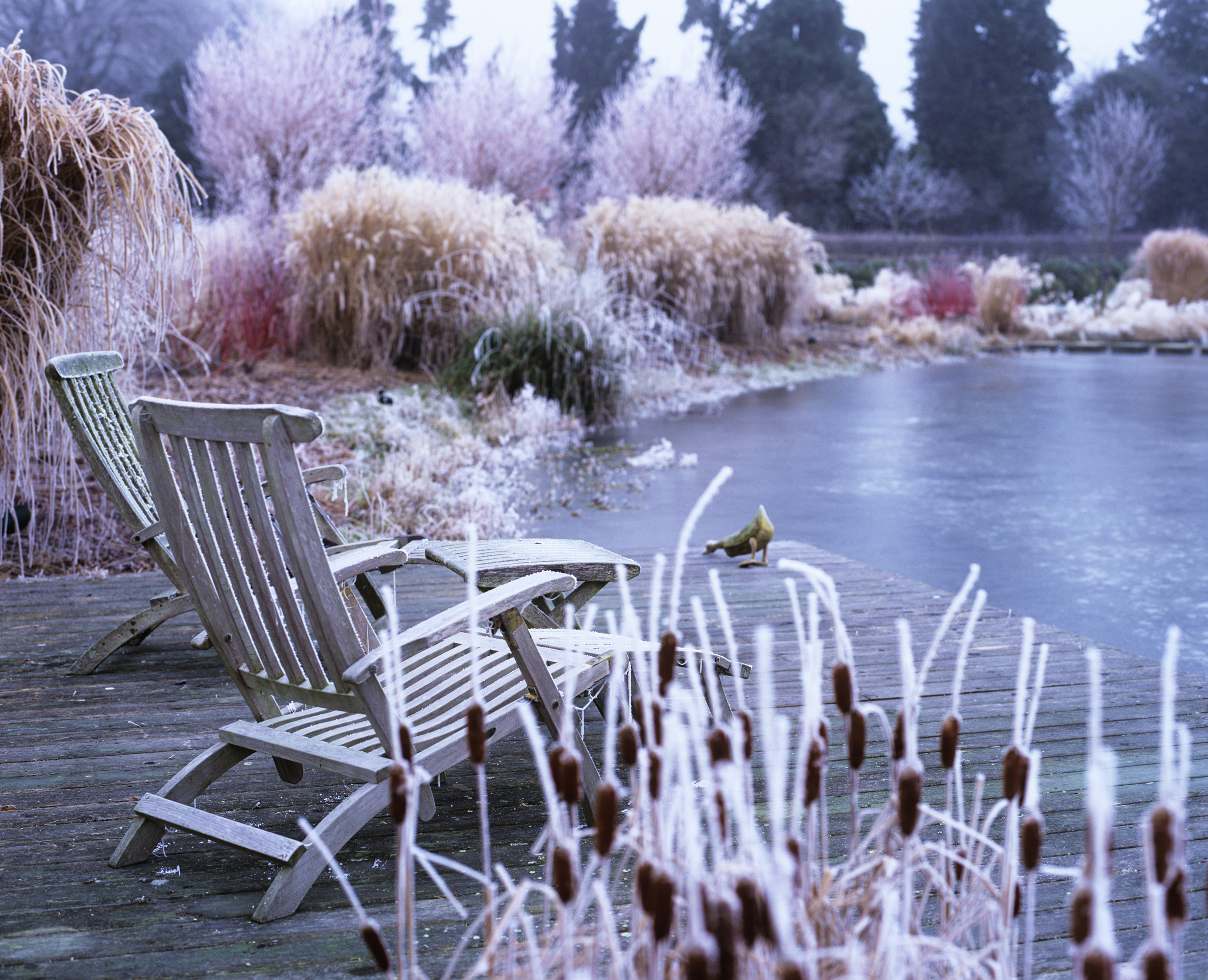
Top tips for winter gardens
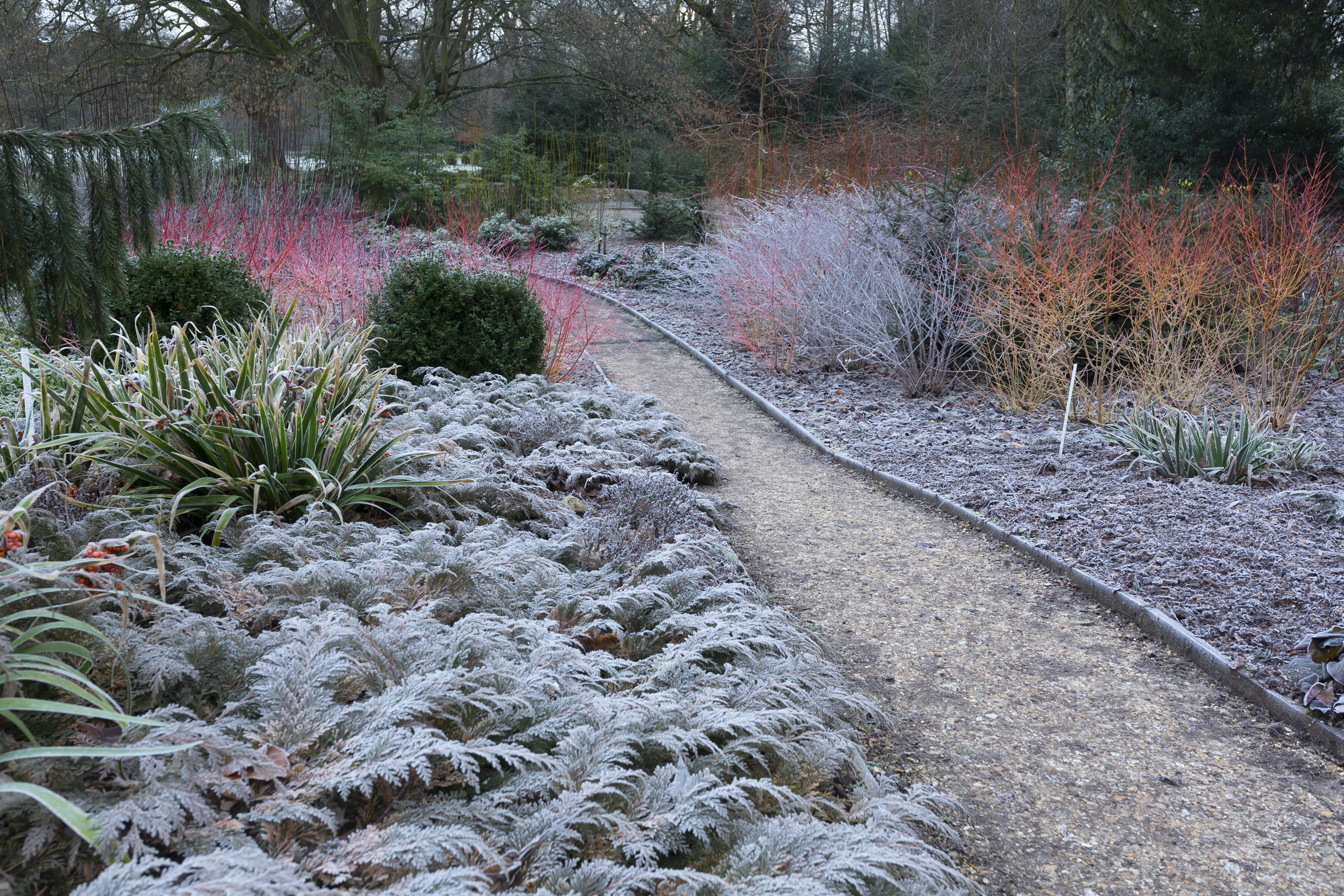
Jonny Norton, head gardener at the National Trust’s Mottisfont, offers winter gardening advice
Soil type: Your winter garden’s location and soil type is key. Choose plants that thrive in the conditions specific to your garden
Low-level planting: Use bulbs and perennials around structural shrubs. Winter aconite, galanthus, crocus, early narcissi and hardy perennials such as Helleborus niger and orientalis are all well worth including.
Pruning: Think about what the plant naturally does and choose your pruning harshness accordingly. We hard prune our salix (willow) in mid-spring just as the new basal shoots emerge which will develop into the graceful stems. This method of pruning is often referred to as stooling
Upkeep: Maintenance in the winter garden is no different to other areas of the garden. We adopt a ‘no dig’ method of gardening (where possible). March/April is the big time for weeding, pruning and mulching
Winter gardens are becoming increasingly popular as our changing climate brings us out into the garden more often during the winter months. There is no need to settle for an empty, desolate outdoor space once the showy summer brights and fiery autumn colours are gone. There are plenty of options for colour, scent, shape and interest to enjoy in a winter garden.
Winter is a more subtle month in the garden, as most of the flowers are not large or showy at this time of the year. It is, however, the time to admire the structure of evergreens, architectural foliage, parchment-toned grasses, vibrant stark stems, beautiful barks, berries and delicately scented flowers.
Read on to find out how to create a winter garden full of interest and for more inspiration, don't miss our garden ideas page.
Where to start when planning a winter garden
Whether you are aiming for a succession of highlight plants throughout the year or embracing the trend for a dedicated winter garden bed, the possibilities are many. Even if it’s just a seasonal container by the door, there are numerous possibilities – such as a specimen dogwood underplanted with with hellebores. Find out more in our guide to container gardening.
From flaming cornus stems lighting up in the winter sunshine above carpets of hellebores, the delicious vanilla scent of Sarcococca ruscifolia (Christmas Box) as it comes into bloom, to the combination of perfume and backlit sunset hues of witch hazels, there is much to inspire.
- For help in establishing a garden design you can take a look at our advice piece.

A dramatic winter garden scene of colourful cornus and grasses caught in the grasp of a hoar frost
Topiary balls add texture and volume, and look lovely when dusted with snow. Contrasts and colours can be intensified in the low shafts of winter light, so think winter plants with colourful branches. On an overcast day, the rich hues will lift your spirits and on a crisp, bright day when the sunlight intensifies the effect, it can be breathtaking.
Take a winter walk through one of the many gardens that stay open year round with specially planted winter gardens, such as Mottisfont in Hampshire, as they are full of inspiration for new winter plants and planting combinations.
Get small space home decor ideas, celeb inspiration, DIY tips and more, straight to your inbox!
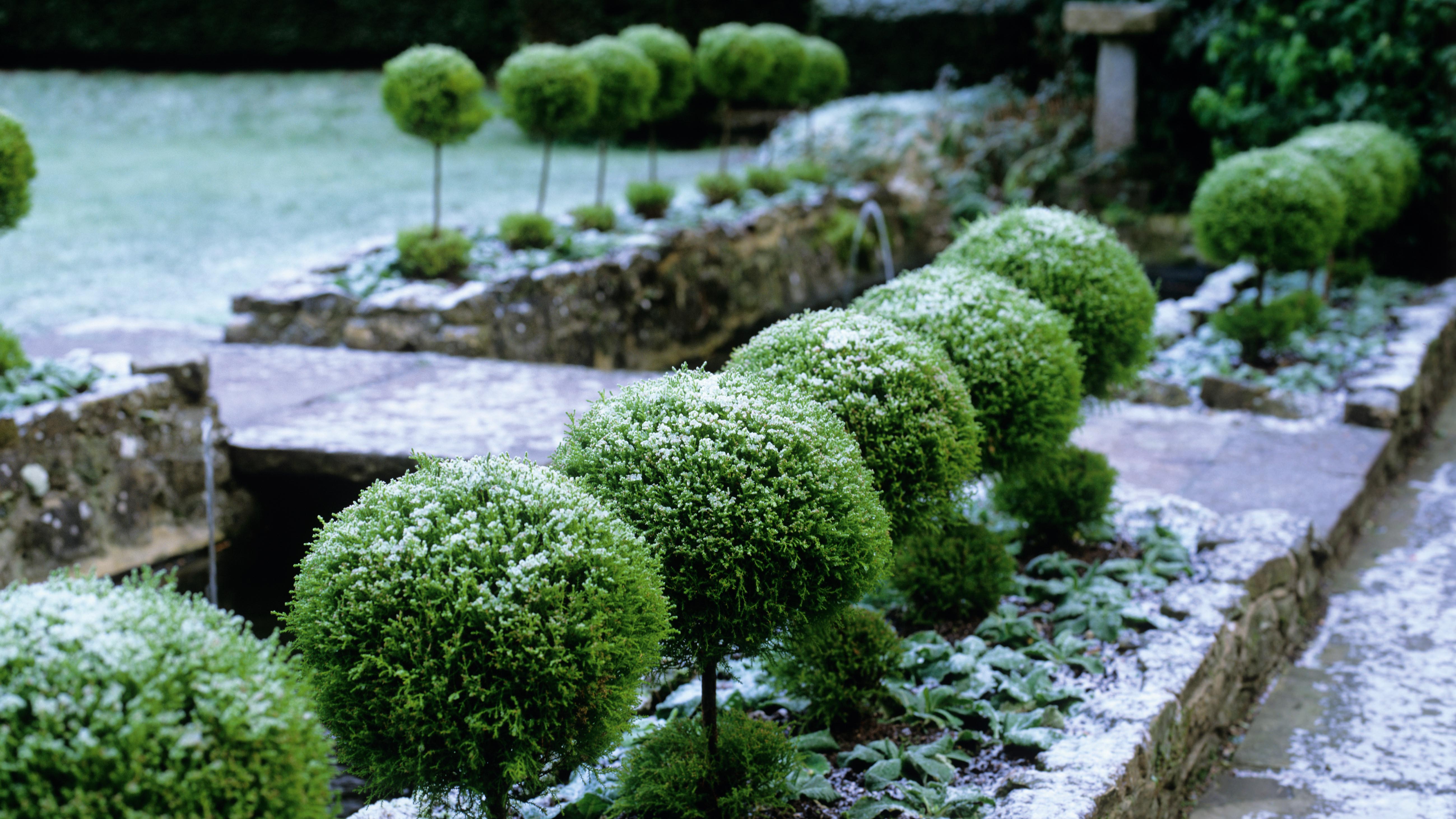
Repeated topiary lollipops dusted with frost lend a formal simplicity to the winter outlook
How to create a winter flowerbed or border
- First, decide where you want to add winter interest and what plants you’d like to use for the look you’re planning to create.
- As we spend less time outdoors in winter, positioning your winter bed where it can be seen from inside is a way to really enjoy the picture you have created.
- Plant east to west to catch the best of the morning and late-afternoon sun, which will light up fiery stems and outline the shapes of deciduous trees.
- Make the most of sweet-smelling winter plants by positioning them by paths – they’ll release their scents as you brush past.
- Many pollinating insects emerge earlier than usual with our mild winters, too, so it’s really important to offer them food from early flowering shrubs and perennials.
- Winter exposes the bare bones of a garden, giving you an opportunity to take a critical look and see where the gaps are.
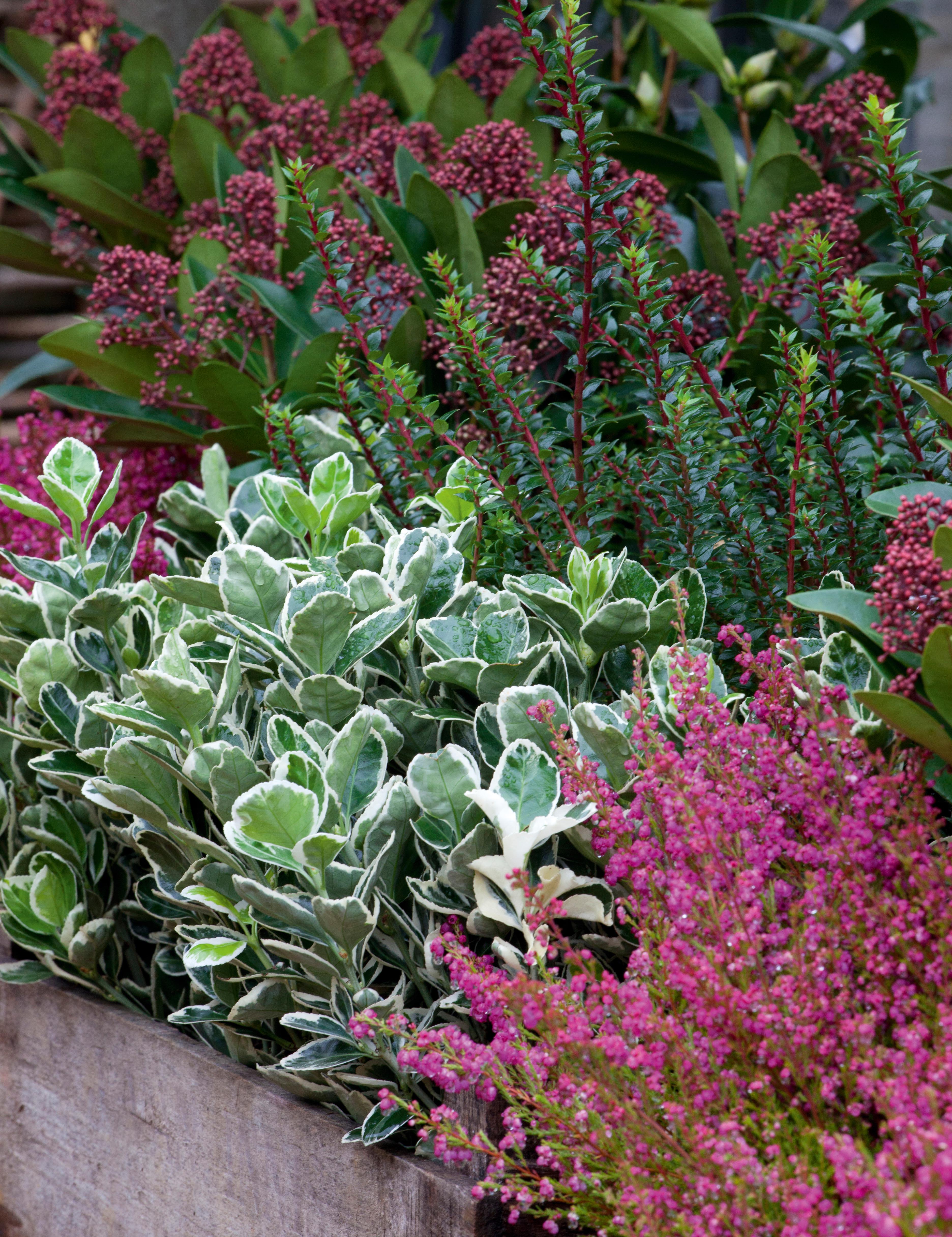
Create mini winter gardens in rustic containers, with pretty combinations of plants such as heather and skimmia
How to choose the right plants for a winter garden
Six top winter plants used at Wakehurst
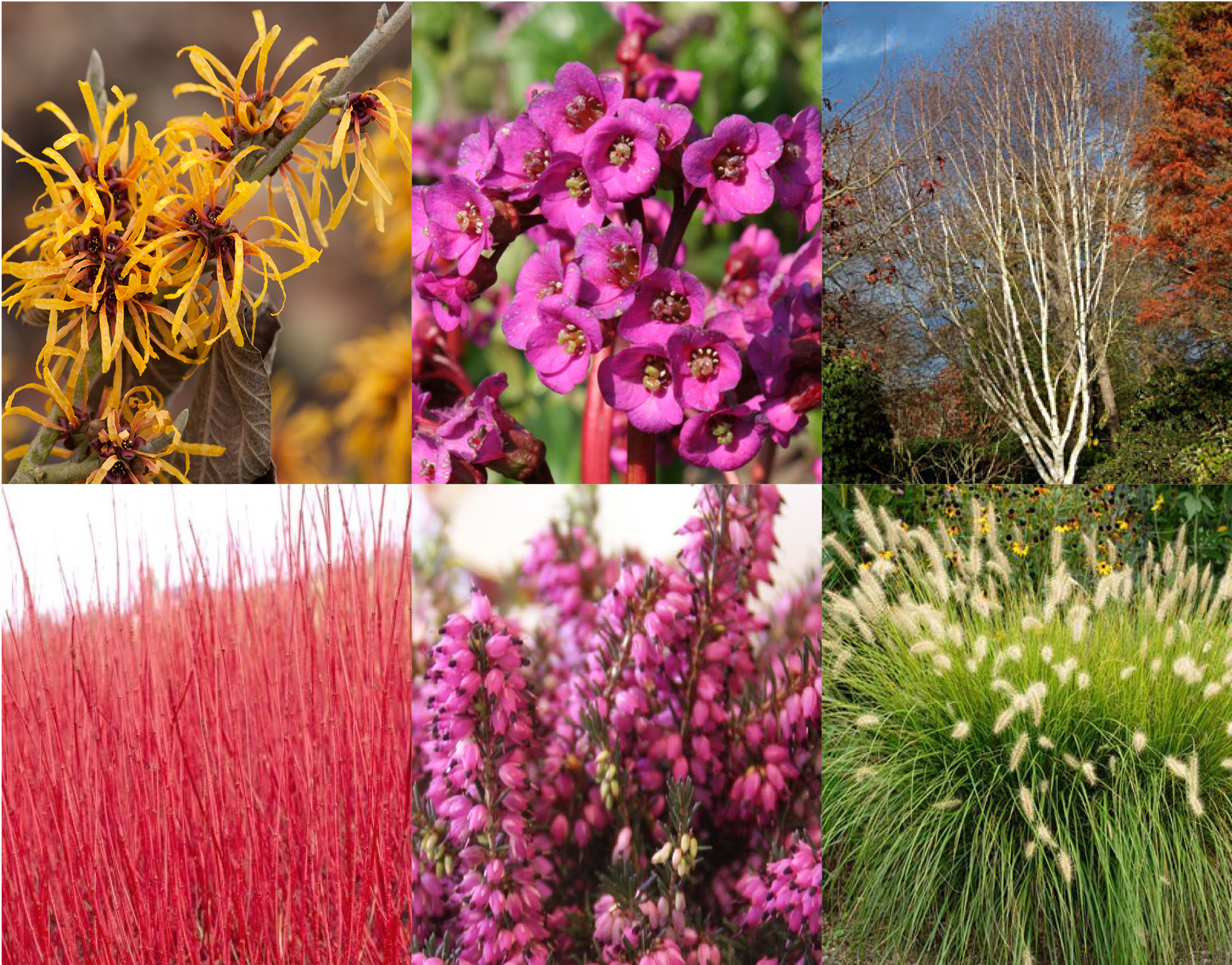
The winter garden at Wakehurst, Kew's wild botanic garden in the Sussex countryside, is full of sensory delight.
(Top row, left to right)
Hamamelis x intermedia ‘Orange Peel’
A sharp citrus fragrance and vibrantly coloured flowers evoking the plant’s name, this Witch Hazel is one of the very best winter flowerers. Plant in free-draining soil near a path and be patient, it’s slow growing but worth the wait.
Bergenia purpurescens ‘Eroica’
This plant is wonderful in large groups for landscape effect, its burnished bronze leaves glinting in the winter sun. Dusky pink flowers follow in the summer and this Bergenia is endearingly vigorous. Plant in semi-shade or full sun in a wide range of soils.
Betula utilis var jacquemontii
Reliably elegant in stature, this tree works wonderfully as an individual specimen for a smaller garden or in a tightly planted grove for larger spaces. It prefers free draining soil and larger specimens should be supported when newly planted, with a low stake and flexible ties.
(Bottom row, left to right)
Cornus alba ‘Sibirica’
Has the most impact when planted in a group and they can tolerate a wide range of soils, preferring some organic matter. Winter Cornus can be cut down hard in the spring to produce strong coloured shoots for the following winter and plants should be fed with a balanced fertiliser after this treatment.
Erica x darlyensis ‘Mediterranean Pink’
This heather has rich pink flowers borne on wiry, compact stems. Always happiest on sandy acid soils, ensure heathers are well watered during establishment.
Pennisetum alopecuroides ‘Hameln’
This grass forms a reliable tight clump and has beautiful squirrel-tale flowers that glow in low light. It loves full sun and free-draining soil and can be interwoven with flowering plants or planted solely in big groups.
With more people adding garden outbuildings as a space in which to work or relax, it's more important than ever to ensure the garden offers a visual and sensory treat year round with winter plants.
Autumn is an ideal time to plant trees and shrubs before the severe frosts arrive, while the soil is still warm. Choose shrubs and trees with multi-season interest, such as cornus for flowers, autumn foliage and winter stems, or prunus for blossom, autumn foliage and gleaming bark in winter. Check the labels to ensure they will suit your garden.
Evergreens provide form year-round, allowing you to paint with shades of green. Look for variegated or strikingly shaped leaves, or those that can be clipped into topiary shapes.
Some have winter flowers, such as mahonias with their golden spikes, and don’t forget the richly scented daphnes. Look for architectural choices such as bamboo, hardy palms, phormiums, yuccas or elegant cloud-pruned Ilex crenata. A repetition of plants gives structure, continuity and a rhythm to your design.
For more advice on winter garden-friendly plants, check out our complete winter plants feature.
Fruiting plants and berries for a winter garden
Hardy fruiting plants carry the colours of autumn into winter with their bright berries in golds, oranges, reds, pinks and even purple, hanging like mini baubles or shining lanterns among evergreen foliage.
Most berry-producing trees and shrubs are easy to grow, don’t need much pruning, and tolerate a range of soils and climatic conditions, including frost, wind and drought. There are choices for both large and small gardens so it’s worth doing a bit of research and visiting your local garden centre to see what’s on offer.
The best way to introduce berries in a small garden is as boundary plants, trained or espaliered against a wall, such as glossy orange, red or yellow berried pyracantha or crimson cotoneaster. Ornamental crab apples have probably the best of all the winter fruits and with their spring blossom have great versatility of sizes.
For a larger space, rows of crab apples could line a drive or be dotted across a lawn, but there are also small varieties that are ideal for compact spaces, courtyards or even containers.

Holly is a great evergreen choice, synonymous with the season. Plant in spring or autumn in well-drained, slightly acidic soil. They like full sun but will grow well in part shade
Don’t overlook the evergreens, such as holly; you can even clip them as topiary for the tiniest space. Red berries in particular are really set off with a foil of deep green foliage behind. Think glossy viburnums, or the much-maligned but hardy cotoneasters, as well as Christmassy hollies, while you’re browsing the garden centre.

Sorbus are deciduous trees with berries in white, pink, yellow, orange, red and blue. They have small spring flowers and some have vibrant autumn colour. They like full sun or dappled shade
Colourful winter stems and bark
Stems
Vibrantly colourful stems are important elements in any winter scheme. Look out for red, orange, yellow, purple or black stems from cornus and willow varieties as well as white from ornamental bramble.
A good tip is to plant where they catch the season’s low sunshine so they can really shine. Planting in drifts, en masse, intensifies the effect of colourful stems, but if space is limited add in some little surprises of colour from colourful stems.
Once they are established, cornus, rubus and willow should be cut back hard in early spring to ground level - this is known as coppicing and ensures a fresh new crop of bright coloured stems each winter. Make sure they are fed and mulched to ensure the best colour, and then – the added bonus – use the cut stems as plant supports.

Cornus 'Midwinter Fire adds vibrant slashes of orange and red to a winter garden
Trees and bark
Many trees trees have beautiful ornamental bark that takes centre stage in autumn when they are not competing with flowers and plants. The beauty of bark can create dynamic effects and combinations with other winter plants in a winter garden.
Colour choices in bark are quite varied, from stark white through to cinnamon red or salmon pink, with varying textures from smooth to furrowed or peeling. Such as a mini copse of shimmering white stems of Betula utilis var. jacquemontii, silky smooth mahogany Prunus serrula or the tactile peeling orange beauty of Acer griseum with its exfoliating peels and curls that catch the light.
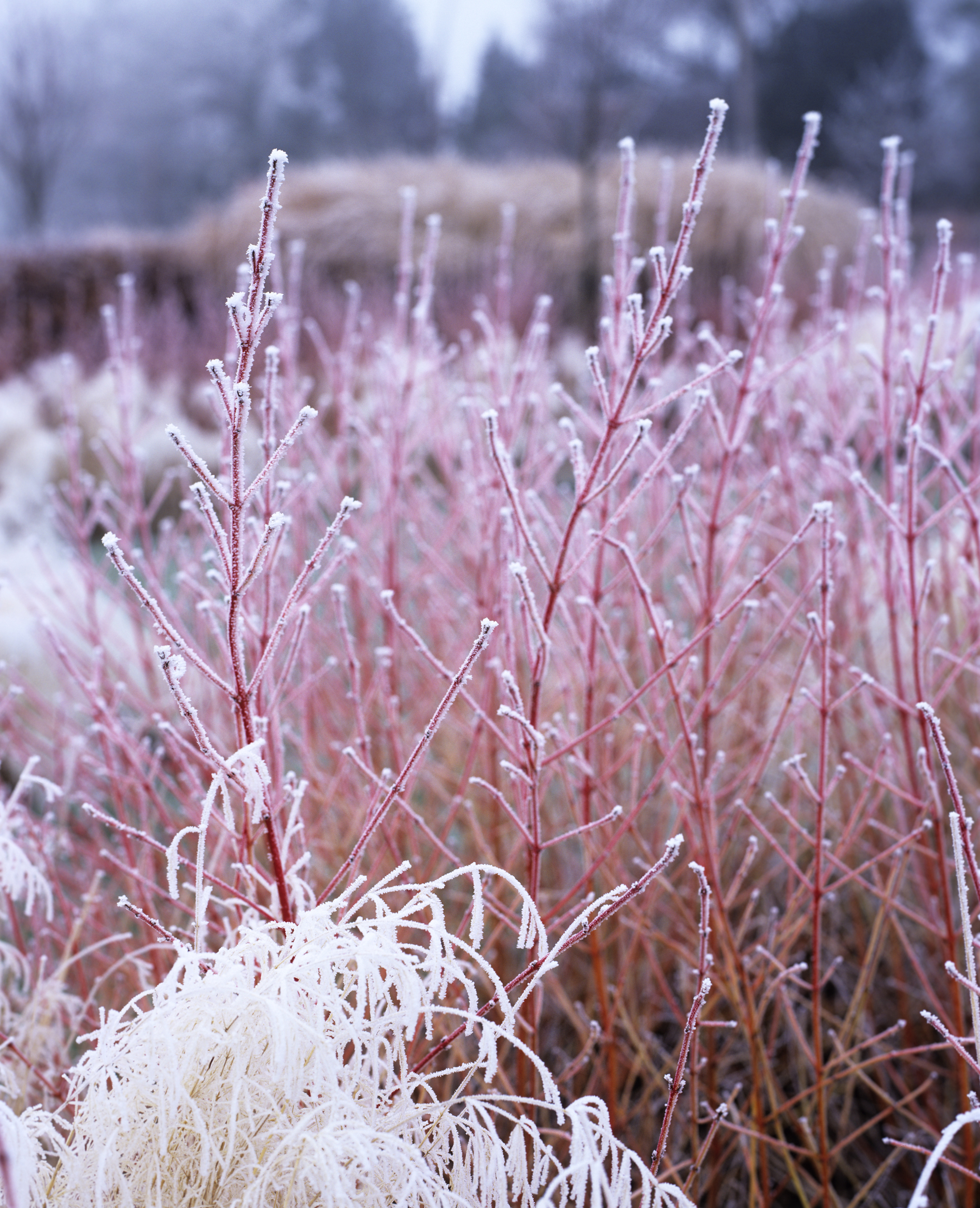
Winter frost adds a magical effect to grasses and cornus stems
Some deciduous trees look especially beautiful in their naked form, such as acers and oaks.
How to make the best impact with winter stems and bark
- Take note of how the light crosses your winter garden to make the most of the power of low, slanting sunlight through the stems, which is especially beautiful in the late afternoon.
- How you use the winter light will be key to the success of the planting impact.
- Take a stroll through an arboretum or woodland to observe the lines of naked deciduous trees or the bark, to help inform your choice.
- For the best effect plant trees in groups and in a position where you can enjoy their winter beauty throughout the season.
- Combine your stems and bark with fragrant winter flowers, early spring bulbs, evergreens and interesting foliage and ground covers.
- Many stems offer multi-season interest, such as cornus and prunus, which also produce flowers and autumn foliage

The gleaming bark of Prunus serrula, backed by a fiery hedge of Cornus sanguinea 'Midwinter Fire'
Winter flowers
Floral beauty may be scarce in a winter garden, but every bloom is appreciated and the rich fragrances of winter flowers are especially welcome. This includes white hellebores and winter honeysuckle to the winter-flowering viburnums, fragrant box and the liquorice scent of spidery Hamamelis (witch hazels).
Nature has a reason for strongly fragrant winter blooms as the more scented the flower, the better its chance of attracting bumblebees or moths.
Allow late- season perennials and ornamental grasses to ‘die heroically’, as the Dutch designer Piet Oudolf puts it. These muted brown hues can grace the garden right through winter.
Complete your design with sculptural pieces for impact year round, such as rustic supports, painted obelisks, recycled finds or a striking sculpture.
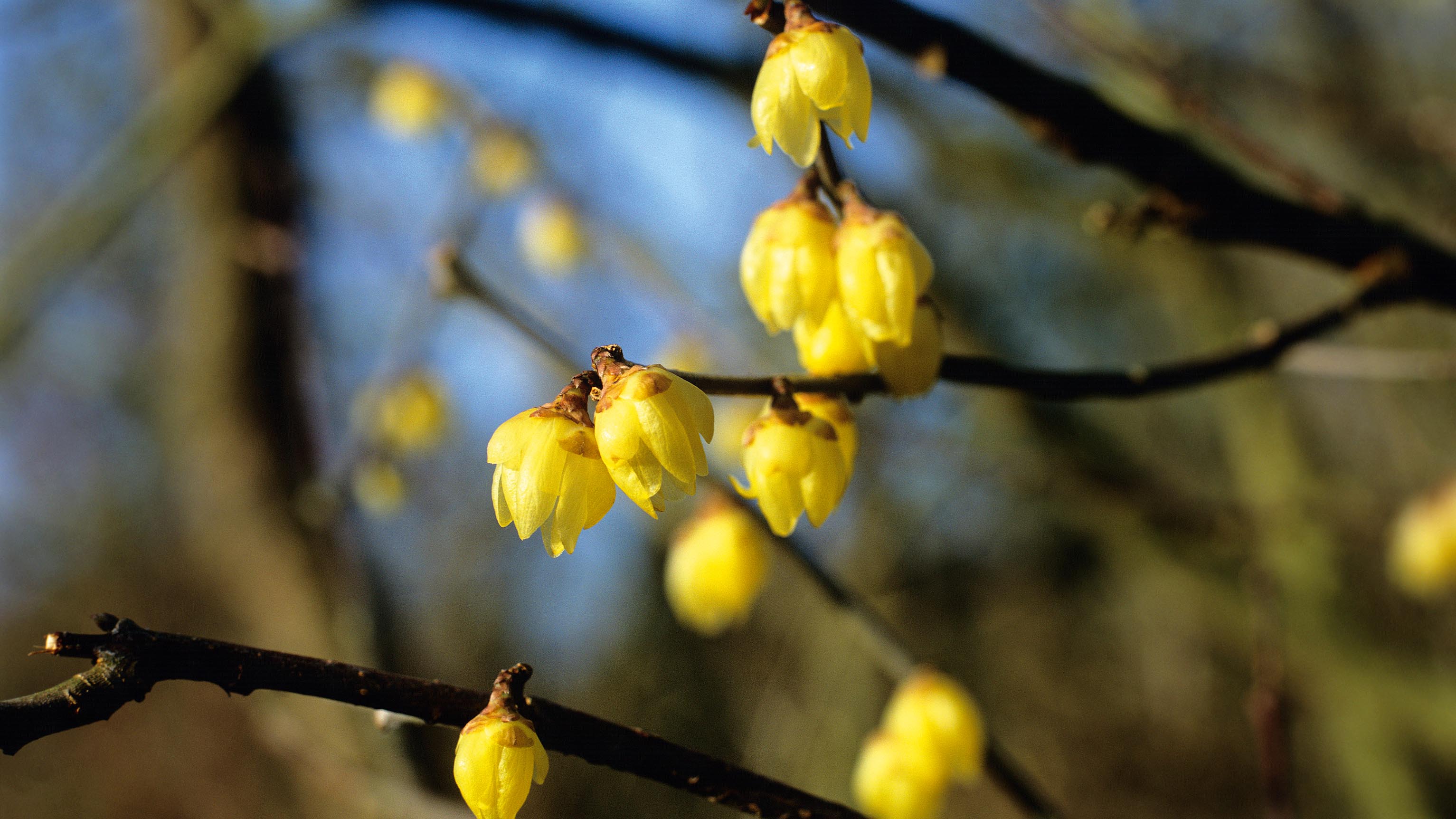
Chimonanthus Praecox is a deciduous shrub with pendulous yellow blooms. Plant in full sun in fertile, well-drained soil in a protected spot. Bring a few sprays inside as it looks wonderful in arrangements
Create a planting scheme
- Take time to observe the subtle combinations at this quieter time in the garden Using a controlled, limited palette of two or three plants in blocks, lends drama to a scheme
- For berries, consider callicarpa and euonymus for the unexpected colours of purple and pink berries
- Select hardy plants that look good through winter with coloured stems or interesting bark
- Balance elements of shape, structure, colour, contrast and texture
- Remember all the levels – from trees and shrubs, grasses and perennials to bulbs and ground covers
Caring for wildlife in a winter garden
ADVICE FROM THE RSPB
Food: Suet balls or cakes are good high-energy foods. Sunflower seeds and nuts are also high in fat, as are small black nyjer seeds - a favourite of goldfinches and siskins. Peanuts should be fed in a secure feeder to avoid birds choking; they can also contain a natural toxin which can kill birds so make sure you buy your peanuts from a reputable trader. Buy high quality bird food, as lower priced foods are often bulked out with nutrient poor grains like barley, or large pulses like lentils and beans, which only the very large birds can eat.
Shelter: Put up a nesting box as small birds will use them as shelter in winter and often come back to the same box in spring to nest. Nest boxes with a hole of 32mm is perfect for blue tits, great tits and house sparrows, while open boxes will attract robins, wrens or pied wagtails.
Site the box to face between north and east, so that it’s shielded from direct sunlight and the wettest winds, and well out of reach of roaming cats and squirrels. House martins and sparrows will be happy in boxes high up in roof eaves, while robins and wrens like to be two metres high.
Spare a thought for the creatures that also call our gardens home as the winter sets in – a few touches now will turn your garden into a wildlife haven.
Providing shelter
Mixed hedges and groups of native species will provide natural food and shelter. Rake some leaves under shrubs, as besides being a great mulch, they will allow birds to forage for insect larvae and beetles. A pile of leaves may be used by a hibernating hedgehog and the warm compost heap can be the winter resort for a variety of animals.
Creating habitats for overwintering can be as simple as leaving some dry plant stems in the beds, the perfect place for insects to crawl inside for shelter. You can also add a log pile, or include trees and shrubs for nesting.
Feeding visitors
Plants with berries and winter flowers provide food for birds or mammals and flowers for pollinators. Don’t forget to keep the birdbath clean and fresh. You can keep it free from ice this by putting a table tennis ball in the water - which will move around keeping the water free from ice.
We can expect visiting birds from abroad alongside native sparrows, starlings, blackbirds, tits, finches and thrushes. Birds need a high fat diet to keep them warm, but if you feed them it needs to be done regularly so they don’t waste energy getting there and finding no food.
Find our more about creating your own luscious wildlife garden.
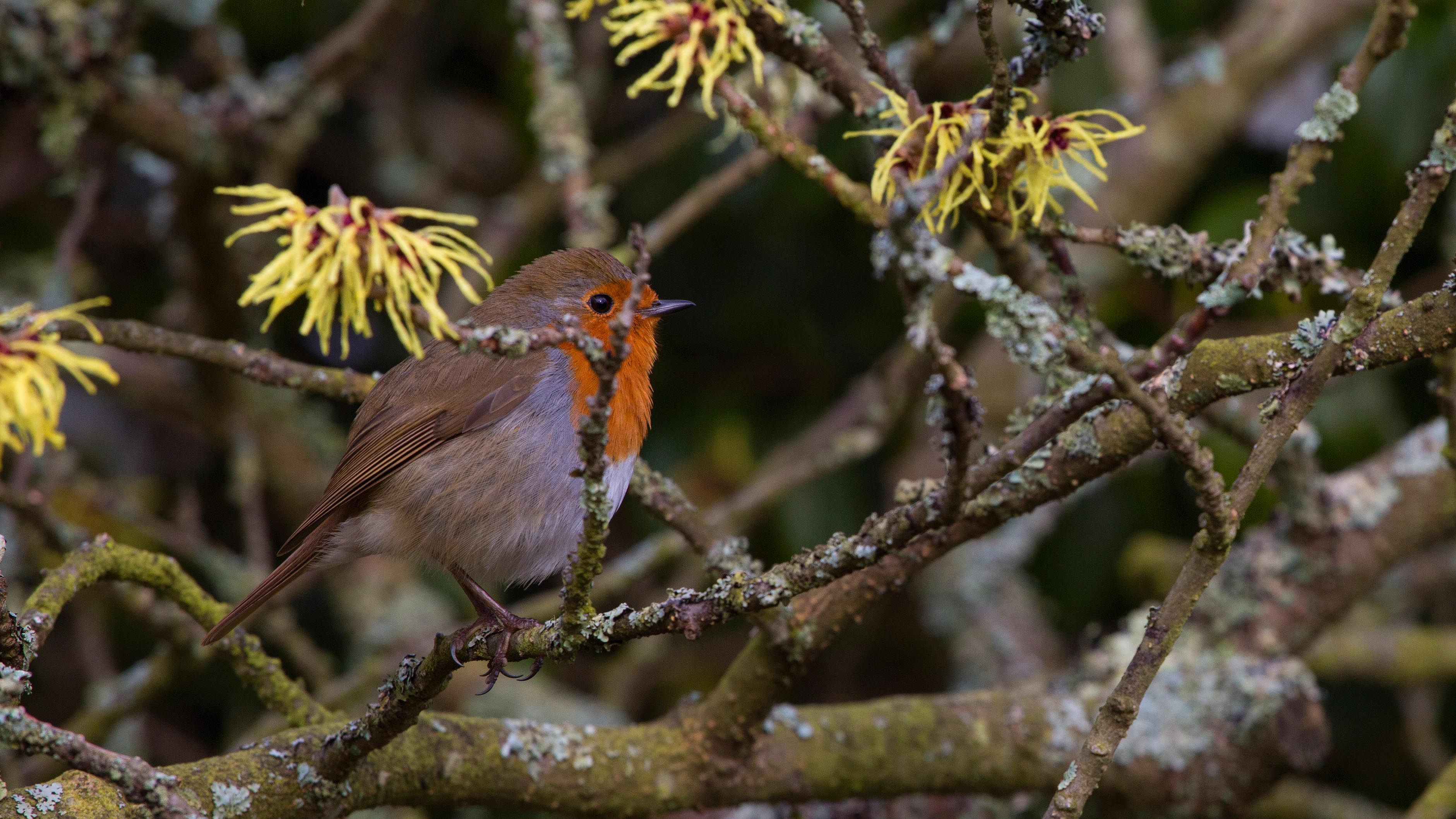
The most resolute symbol of British winter, the robin is one of the few birds to be singing all year round, warding off intruders with its song
Winter gardens to visit
MORE FROM PERIOD LIVING

Get the best period home inspiration, ideas and advice straight to your door every month with a subscription to Period Living magazine
Take a winter walk through one of the many gardens that now stay open year round with specially planted winter garden areas. They are full of inspiration for combinations and new plants that you can translate to your own garden, even on the tiniest scale.
Mottisfont
Romsey, Hampshire, SO51 0LP
Sloping winter garden with thousands of winter and early spring bulbs.
Anglesey Abbey
Lode, Cambridgeshire CB25 9EJ
Vibrant colours, textures and scents fill the winter garden, with honeysuckle, silver fern brambles and sarcococca.
RHS Harlow Carr
Harrogate, Yorkshire, HG3 1UE
Grasses star in winter, with masterful use of bright stems and trees, plus raised veg beds.
The Savill Garden
Englefield Green, Surrey, TW20 0UU
Ornamental winter beds with vibrant stems, witch hazels, and national mahonia collection.
Wakehurst Place
Ardingly, West Sussex, RH17 6TN
Kew’s country seat is full of architectural greens, scents, textural barks and parchment-toned grasses. The new winter garden, is full of sensory delight and the perfect place to lift the spirits on a cold winter’s day. It weaves 33,000 plants into a bold contemporary composition. Mature Himalayan silver birch trees are the centre of attention, the dramatic pure white trunks interspersed with the coppery gleam of the Tibetan Cherry. Texture and colour come from massed blocks of cornus, succulent bronze bergenia, soft, feather-like calamagrostis and hellebores. Swathes of cyclamen, grasses, snowdrops, crocus and box hedging draw the eye through the garden. The all-weather path twists and turns throughout the garden, adding to the feeling of discovery – you don’t quite know what you will see around the next corner.
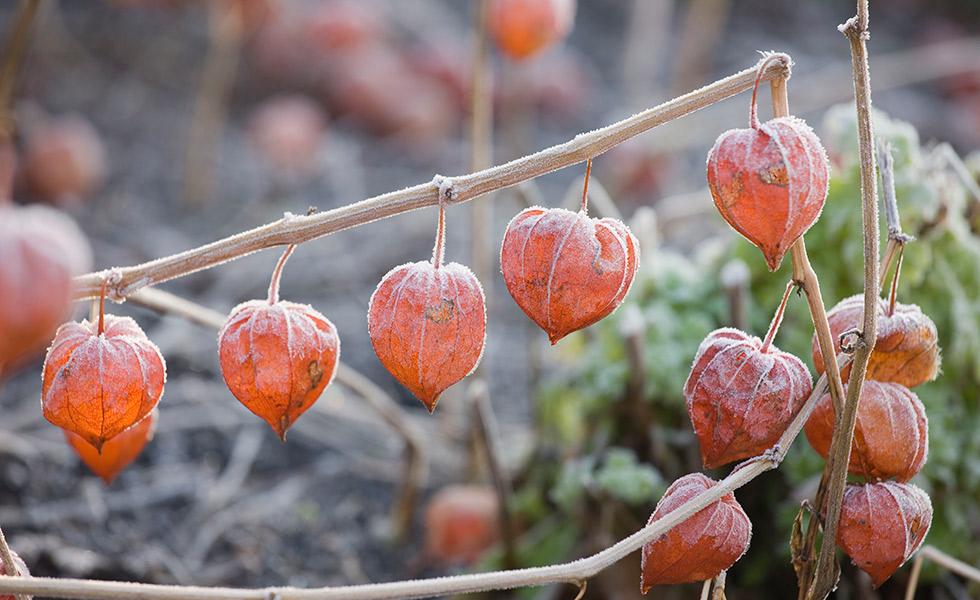
Read more:
- Advice on winter garden preparation
- Spring gardening how to prepare
- Garden jobs month by month
- Garden landscaping ideas: a complete how to